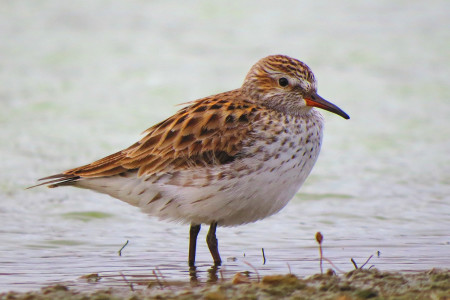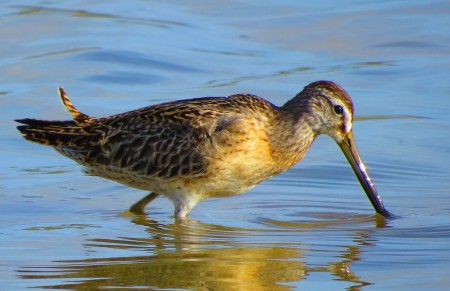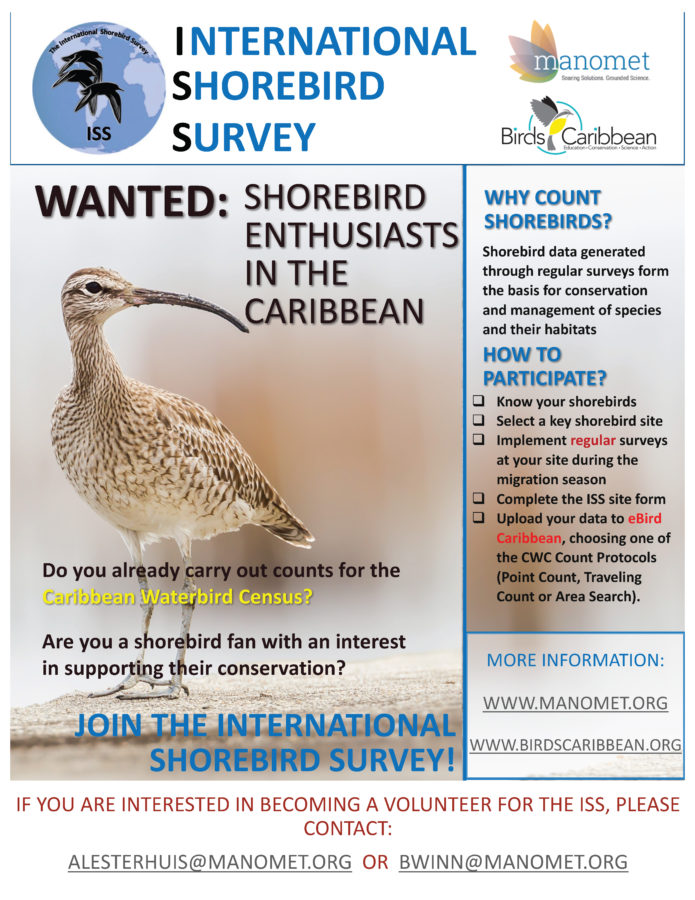
Are you a shorebird fan and want to support their conservation? Do you already carry out counts for the Caribbean Waterbird Census? Then join the International Shorebird Survey (ISS). Lisa Sorenson explains how to participate.
It’s that time of year when our islands are inundated with avian visitors —a great variety of delightful birds that have winged their way south to escape the soon-to-be-frozen north and take refuge in our sunny isles. They brighten our backyards, parks and ponds, and make birding ventures much more fun and interesting – what new migrant might surprise us today? I have had the good fortune to spend a little time in both Cuba and Bonaire the last few weeks and carry out surveys at various wetlands and coastal sites on each island – the large number of shorebirds at some sites, hungrily probing for invertebrates in the mud or snapping up brine flies out of the air was amazing.
Thanks to the great work you all are doing in gathering data through the Caribbean Waterbird Census (CWC) and International Piping Plover Census, the importance of this region for waterbirds and shorebirds is becoming better understood at a rapid rate. Your counts are revealing that many shorebirds use the region as a winter home or as a place to rest and refuel during their long migrations. Your counts are also showing that a number of sites are of critical importance to migratory shorebirds, a group that has been showing serious population declines for the last 15 years. In order to further document numbers and long-term trends and gather additional information to help conserve these sites, there is a need for more regular monitoring data, especially during migration.
Knowing that many of you already go out to count waterbirds for the CWC, we would like to invite you to schedule some extra counts during the migration season in the Caribbean and with that, become a volunteer for the International Shorebird Survey (ISS).
ISS is an initiative organized by Manomet since 1974 and is a volunteer-based monitoring program specifically focusing on counting shorebirds during the southbound and northbound migration. These surveys are implemented throughout the Western Hemisphere and the data that has been gathered by volunteers has proven key to shorebird conservation planning.
How to participate? Easy!

Just go to a/your nearby shorebird site two or three times a month during the migration season (August-October and March-May) and count all shorebirds. As the ISS protocol is basically the same as your CWC protocol—you can do both counts at the same time. Simply do a CWC count, making sure to count all birds, and enter your data as usual choosing choosing one of the CWC Count Protocols (Point Count, Traveling Count or Area Search) on Step 2 of “Submit observations” in eBird Caribbean (make sure you use our Caribbean eBird portal to be able to choose the CWC protocol).
More information on the ISS is in these flyers (English, Spanish), which you are welcome to distribute to other potential volunteers. You can also learn more on this website.
If you are interested but have further questions, please do not hesitate to contact Arne Lesterhuis (Alesterhuis@manomet.org) or Lisa Sorenson (Lisa.Sorenson@BirdsCaribbean.org).
Many thanks in advance for helping us to document the importance of our islands to shorebirds (see for example, Bonaire). We hope to see folks participating in the ISS soon!
By Lisa Sorenson, Shorebird Enthusiast and Executive Director of BirdsCaribbean
p.s. Here is a link to some helpful resources for counting shorebirds, a very challenging group to identify. It takes years of experience to become really good at shorebird ID, but learning is great fun. Here are some quick tips:
- Go out and practice as often as possible. Spend as many hours as you can watching shorebirds, noting their overall size and body shape, feeding method, color and shape of bill, color and length of legs, call and behavior. Based on body and bill size and shape, learn to recognize groups, such as plovers vs. sandpipers. You will need to be a detective and work out the identification based on multiple subtle clues.
- Try to learn a few common species really well that will serve as a reference (‘marker bird”) for size comparisons with species that you know less well.
- If you are not sure about the ID, don’t guess! It’s much better to enter the data as “plover sp” or “peep sp” or “large shorebird” – various options like this are provided on eBird Caribbean – then enter inaccurate information.
- Take photos of any species you are not sure of and send them to us for help with ID. This will help ensure that data quality remains high and help you to become proficient at identifying shorebirds.
- Arm yourself with really great field guides, study them and make notes on the pages. In addition to Birds of the West Indies, by Raffaele et al, we recommend Stokes Beginners Guide to Shorebirds by Don and Lillian Stokes (excellent small book with KEY ID tips and great photos!). The Shorebird Guide by O’Brien, Crossley and Karlson is also great.
Download the Site Form.

